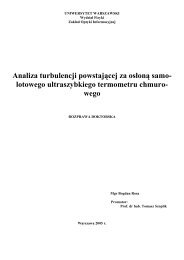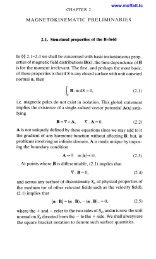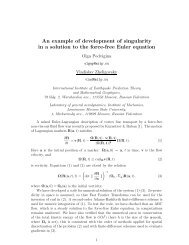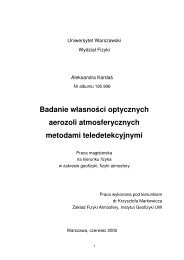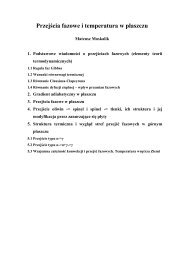Flow of fluid of non-uniform viscosity in converging and diverging ...
Flow of fluid of non-uniform viscosity in converging and diverging ...
Flow of fluid of non-uniform viscosity in converging and diverging ...
You also want an ePaper? Increase the reach of your titles
YUMPU automatically turns print PDFs into web optimized ePapers that Google loves.
J. Fluid Mech. (1982), vol. 117, pp. 283-304<br />
Pr<strong>in</strong>ted <strong>in</strong> Great Brita<strong>in</strong><br />
<strong>Flow</strong> <strong>of</strong> <strong>fluid</strong> <strong>of</strong> <strong>non</strong>-<strong>uniform</strong> <strong>viscosity</strong> <strong>in</strong> converg<strong>in</strong>g <strong>and</strong><br />
diverg<strong>in</strong>g channels<br />
By ALISON HOOPER,<br />
School <strong>of</strong> Mathematics, Bristol University<br />
B. R. DUFFY AND H. K. MOFFATT<br />
Department <strong>of</strong> Applied Mathematics <strong>and</strong> Theoretical Physics,<br />
Silver Street, Cambridge<br />
(Received 17 February 1981 <strong>and</strong> <strong>in</strong> revised form 9 July 1981)<br />
It is shown that the well-known Jeffery-Hamel solution <strong>of</strong> the Navier-Stokes equations<br />
admits generalization to the case <strong>in</strong> which the <strong>viscosity</strong> ,U <strong>and</strong> density p are arbitrary<br />
functions <strong>of</strong> the angular co-ord<strong>in</strong>ateo. When I Raj < 1, where R is the Reynolds number<br />
<strong>and</strong> 2a the angle <strong>of</strong> divergence <strong>of</strong> the planes, lubrication theory is applicable; this<br />
limit is first treated <strong>in</strong> the context <strong>of</strong> flow <strong>in</strong> a channel <strong>of</strong> slowly vary<strong>in</strong>g width. The<br />
Jeffery-Hamel problem proper is treated <strong>in</strong> $93-6, <strong>and</strong> the effect <strong>of</strong> vary<strong>in</strong>g the<br />
<strong>viscosity</strong> ratio h <strong>in</strong> a two-<strong>fluid</strong> situation is studied. In $ 5, results already familiar <strong>in</strong><br />
the s<strong>in</strong>gle-<strong>fluid</strong> context are recapitulated <strong>and</strong> reformulated <strong>in</strong> a manner that admits<br />
immediate adaptation to the two-<strong>fluid</strong> situation, <strong>and</strong> <strong>in</strong> $6 it is shown that the s<strong>in</strong>gle-<br />
<strong>fluid</strong> limit (A +- 1) is <strong>in</strong> a certa<strong>in</strong> sense degenerate. The necessarily discont<strong>in</strong>uous<br />
behaviour <strong>of</strong> the velocity pr<strong>of</strong>ile as the Reynolds number (based on volume flux)<br />
<strong>in</strong>creases is elucidated. F<strong>in</strong>ally, <strong>in</strong> $ 7, some comments are made about the realizability<br />
<strong>of</strong> these flows <strong>and</strong> about <strong>in</strong>stabilities to which they may be subject.<br />
1. Introduction<br />
<strong>Flow</strong>s with <strong>non</strong>-<strong>uniform</strong> <strong>viscosity</strong>, particularly two-<strong>fluid</strong> flows with a <strong>viscosity</strong> jump<br />
at the <strong>in</strong>terface, arise <strong>in</strong> many processes <strong>of</strong> technological importance. Analysis <strong>of</strong> such<br />
problems is complicated (i) by the fact that the <strong>in</strong>terface geometry <strong>in</strong> general changes<br />
with time even if the boundary conditions are steady, <strong>and</strong> (ii) by the fact that, if the<br />
<strong>in</strong>terface <strong>in</strong>tersects a solid boundary, the no-slip condition is (<strong>in</strong> general) <strong>in</strong>adequate <strong>in</strong><br />
an immediate neighbourhood <strong>of</strong> the contact l<strong>in</strong>e, which may be observed to move<br />
relative to the solid surface.<br />
In attempt<strong>in</strong>g to approach problems <strong>in</strong> this category <strong>in</strong> a general way, it seems<br />
natural first to study situations <strong>in</strong> which these particular difficulties are avoided.<br />
Figure I shows one such situation, viz the flow <strong>of</strong> a <strong>fluid</strong> <strong>of</strong> <strong>non</strong>-<strong>uniform</strong> <strong>viscosity</strong><br />
along a two-dimensional duct <strong>of</strong> slowly vary<strong>in</strong>g width. This elementary problem is<br />
analysed (under the lubrication approximation) <strong>in</strong> $ 2, <strong>in</strong> order to provide motivation<br />
for the subsequent study ($$ 3-7) <strong>of</strong> the Jeffery-Hamel configuration (figure 2), which<br />
is the ma<strong>in</strong> content <strong>of</strong> this paper. In $ 3, we show that the well-known exact solution <strong>of</strong><br />
the Navier-Stokes equations (Jeffery 1915, Hamel 1916; see Batchelor 1967, 5 5.6)<br />
can be generalized to the situation <strong>in</strong> which the <strong>viscosity</strong> ,U <strong>and</strong>/or the density p are<br />
10 FLM 117<br />
283 w
284 A. Hooper, B. R. Duffy <strong>and</strong> H. K. M<strong>of</strong>fatt<br />
arbitrary functions <strong>of</strong> the angular co-ord<strong>in</strong>ate 0 - conditions that are clearly com-<br />
patible with a steady purely radial flow. A cont<strong>in</strong>uous variation <strong>of</strong> p <strong>and</strong> p can be<br />
<strong>in</strong>duced by heat<strong>in</strong>g one boundary, <strong>and</strong> <strong>in</strong> this case ($ 3) an exact solution <strong>of</strong> the coupled<br />
<strong>non</strong>l<strong>in</strong>ear equations <strong>of</strong> motion <strong>and</strong> heat transfer may be obta<strong>in</strong>ed.<br />
In §$ 4-6, we specialize to the two-<strong>fluid</strong> problem <strong>of</strong> figure 2 (c), <strong>in</strong> which the density is<br />
cont<strong>in</strong>uous, but the <strong>viscosity</strong> is discont<strong>in</strong>uous across 0 = 0. In 5 4, the low-Reynolds-<br />
number analysis for this situation is presented, <strong>and</strong> the upper limit <strong>of</strong> the angle 2a for<br />
which purely radial flow may be expected is obta<strong>in</strong>ed. In $5, results that are well-<br />
known for the <strong>uniform</strong> <strong>viscosity</strong> case are obta<strong>in</strong>ed by a numerical procedure <strong>and</strong> are<br />
<strong>in</strong>terpreted <strong>in</strong> a new light. In 5 6, the same numerical procedure is used to analyse the<br />
effects <strong>of</strong> the <strong>viscosity</strong> jump, <strong>and</strong> it emerges that an important effect <strong>of</strong> the <strong>viscosity</strong><br />
stratification is to resolve the degeneracy implied by the possible existence <strong>of</strong> steady<br />
asymmetric solutions which (<strong>in</strong> the <strong>uniform</strong>-<strong>viscosity</strong> case) are mirror images <strong>of</strong> each<br />
other. Resolution <strong>of</strong> this degeneracy also implies important qualitative changes <strong>in</strong> the<br />
behaviour <strong>of</strong> the flow as the Reynolds number <strong>in</strong>creases.<br />
2. <strong>Flow</strong> <strong>of</strong> <strong>viscosity</strong>-stratified <strong>fluid</strong> <strong>in</strong> a slo\trly vary<strong>in</strong>g channel<br />
In the situation <strong>of</strong> figure 1 (a), let a be a typical wall slope, <strong>and</strong> let R = Qp/jl, where<br />
2Q is the total flux <strong>of</strong> <strong>fluid</strong>, <strong>and</strong> jl is the average <strong>viscosity</strong> across the channel. Then we<br />
may expect that the lubrication approximation will be valid provided that<br />
a< 1, Ra< 1. (2.1)<br />
The natural transverse co-ord<strong>in</strong>ate is<br />
<strong>and</strong>, <strong>in</strong> the lubrication approximation, the streaml<strong>in</strong>es are given by<br />
A steady flow is possible ifp is constant on streaml<strong>in</strong>es, i.e. if<br />
P = Pu('I)*<br />
The velocity u(7) along the streaml<strong>in</strong>es then satisfies<br />
$: (pg) = -G(x),<br />
where<br />
G(x) = - ap/a~, U(X) = al(x) +u,(x).<br />
With boundary conditions u(0) = u(1) = 0, (2.4) <strong>in</strong>tegrates to give<br />
where<br />
= const.<br />
(2.3)<br />
In the two-<strong>fluid</strong> case shown <strong>in</strong> figure 1 (b), the <strong>in</strong>terface y = h(x) becomes 7 = H,<br />
where
<strong>Flow</strong> <strong>of</strong> &id <strong>of</strong> <strong>non</strong>-<strong>uniform</strong> <strong>viscosity</strong> 285<br />
(U ) (b) (C)<br />
FIGURE 1. <strong>Flow</strong> <strong>in</strong> a slowly vary<strong>in</strong>g channel with <strong>viscosity</strong> stratification: (a) cont<strong>in</strong>uous variation<br />
<strong>of</strong> <strong>viscosity</strong>; (b) two-layer model; (c) two layers enter<strong>in</strong>g a slowly diverg<strong>in</strong>g section; the <strong>in</strong>terface<br />
positions itself <strong>in</strong> the diverg<strong>in</strong>g section along a plane 0 = const.<br />
i.e. the ratio <strong>of</strong> widths <strong>of</strong> the two layers is constant. The <strong>viscosity</strong> function is<br />
In the lower <strong>fluid</strong> (<strong>viscosity</strong> p2), (2.6) gives<br />
a2G<br />
U = uz(7) = - (77 - W),<br />
P2<br />
<strong>and</strong> the flux <strong>in</strong> this laver is .I<br />
Q2 = ajru2(q)dq = a3G -(3?j-H)H2.<br />
Similarly,<br />
where (cf. 2.10)<br />
6PZ<br />
a3G<br />
1 - -(3?j'-(l-H))(l-H)',<br />
- 6Pl<br />
27' =<br />
l+(A-l-l)(l-H)2<br />
1 + (A-1- 1) (1 -H) .<br />
Clearly, s<strong>in</strong>ce Q1 <strong>and</strong> Q2 are both constant, we must have<br />
Moreover, elim<strong>in</strong>ation <strong>of</strong> a3G from (2.12) <strong>and</strong> (2.13) yields<br />
(2.9)<br />
(2.10)<br />
(2.11)<br />
(2.12)<br />
(2.13)<br />
(2.14)<br />
a3G = const. (2.15)<br />
AqH'[AH' + (1 - H) (3 + H)] = (1 - H)' [( 1 - H)2 + A H(4 -H)] (2.16)<br />
(where q = Q1/Q2), a quartic equation for H, which has a unique real root H(q, A) <strong>in</strong> the<br />
physically relevant range 0 < H < 1.<br />
We have neglected surface tension <strong>in</strong> the above analysis. The pressure jump due to<br />
surface tension y is approximately y a2h/ax2, <strong>and</strong> the associated jump <strong>in</strong> pressure<br />
gradient along the <strong>in</strong>terface is y a3h/ax3. If, for example, h(x) = h, cos kx, with a = h,k,<br />
this jump has order <strong>of</strong> magnitude ya3/h& <strong>and</strong> this is negligible compared with<br />
lap/ax] N jiQ/ai (where a, is a typical value <strong>of</strong> a(x)) provided that<br />
(2.17)<br />
For very slow flow rates, surface tension <strong>in</strong>evitably becomes important, <strong>and</strong> will tend<br />
to keep the <strong>in</strong>terface plane <strong>in</strong> the situation sketched <strong>in</strong> figure 1 (b).<br />
For the particular case <strong>of</strong> a cha,nnel that diverges at a constant angle (figure Ic),<br />
10-2
286 A. Hooper, B. R. Duffy <strong>and</strong> H. K. M<strong>of</strong>fatt<br />
the condition (2.8) implies that the streaml<strong>in</strong>es <strong>in</strong> the diverg<strong>in</strong>g section are purely<br />
radial (0 = const. <strong>in</strong> polar co-ord<strong>in</strong>ates with orig<strong>in</strong> r = 0 at the (virtual) <strong>in</strong>tersection <strong>of</strong><br />
the diverg<strong>in</strong>g planes). Hence, <strong>in</strong> the diverg<strong>in</strong>g section, ,U = ,u(0), <strong>and</strong> ucc f (0)/r, from<br />
mass conservation. The above simple analysis is <strong>of</strong> course valid only if the conditions<br />
(2.1) are satisfied.<br />
In 9 3, we relax these conditions, <strong>and</strong> consider the general Jeffery-Hamel problem<br />
for arbitrary a <strong>and</strong> R, <strong>and</strong> arbitrary ,U(@. We shall also allow the density p to be a<br />
function <strong>of</strong> 6; s<strong>in</strong>ce <strong>in</strong>ertia is, <strong>in</strong> general, important, this will also have an <strong>in</strong>fluence on<br />
the velocity field.<br />
3. Jeffery-Hamel flow with ,U = p(O), p = p(0)<br />
Consider now the flow configuration <strong>of</strong> figure 2 (a), with p = ,U(@), p = p(8). Let<br />
<strong>and</strong> let ji(0) = p/p, p”(0) = p/p. In polar co-ord<strong>in</strong>ates (r, 0, z), let<br />
u=2= -,o,o.<br />
P 1<br />
Then the radial <strong>and</strong> transverse components <strong>of</strong> the Navier-Stokes equations are<br />
where p(r, 6) is the pressure field. From the second <strong>of</strong> these,<br />
where c is constant, <strong>and</strong>po is at most a function <strong>of</strong> r. Substitution <strong>in</strong> ( 3.3~) shows that<br />
po may be taken to be constant, <strong>and</strong> we obta<strong>in</strong><br />
f)f (jif +<br />
4jif + 2pf 2 = c. (3.5)<br />
This is the required generalization <strong>of</strong> the st<strong>and</strong>ard Jeffery-Hamel equation<br />
ff‘+4f+2f2= c.<br />
The boundary conditions are<br />
f = O on 8=+a,<br />
<strong>and</strong> it follows from (3.3) <strong>and</strong> (3.5) that<br />
The constant c therefore provides a measure <strong>of</strong> the wall pressure gradient.<br />
If f (0, a, c, A) is any solution <strong>of</strong> (3.5), (3.7), where the ‘parameter’ A summarizes the<br />
dependence on the functions ji(8) <strong>and</strong> p”(O),f then we may construct a correspond<strong>in</strong>g<br />
Reynolds number<br />
R = QP/p = f(e, a, c, A) de = ~ (a, c, A), (3.9)<br />
1 a<br />
where R > 0 corresponds to (net) diverg<strong>in</strong>g flow, <strong>and</strong> R < 0 corresponds to (net) con-<br />
verg<strong>in</strong>g flow. For fixed a, (3.9) provides a relationship (<strong>in</strong> effect) between wall pressure<br />
gradient (i.e. c) <strong>and</strong> flow rate (i.e. R).<br />
t Strictly, <strong>of</strong> course, this is a functional dependence.
<strong>Flow</strong> <strong>of</strong> Jluid <strong>of</strong> <strong>non</strong>-<strong>uniform</strong> <strong>viscosity</strong> 287<br />
FIGURE 2. The Jeffery-Hamel configuration: (a) source flow (& > 0) or s<strong>in</strong>k flow (& < 0) with<br />
angular stratification <strong>of</strong> ,U <strong>and</strong> p; (b) angular stratification caused by differential heat<strong>in</strong>g <strong>of</strong> the<br />
boundaries 8 = f a; (c) the two-layer flow studied <strong>in</strong> $1 4 <strong>and</strong> 6.<br />
In the well-studied case <strong>of</strong> a s<strong>in</strong>gle <strong>fluid</strong> <strong>of</strong> homogeneous properties, the parameter A<br />
<strong>of</strong> course disappears <strong>and</strong> we have a relationship<br />
R = R(a, c), (3.10)<br />
which def<strong>in</strong>es a surface (with possibly many folds <strong>and</strong> branches) <strong>in</strong> the space <strong>of</strong> the<br />
variables (R, a, c). The geometry <strong>of</strong> this surface provides important <strong>in</strong>formation both<br />
about the multiplicity<strong>of</strong> steady-state solutions <strong>and</strong> about the manner <strong>in</strong> which a solution<br />
changes as a or R is slowly varied. A classification <strong>of</strong> velocity pr<strong>of</strong>iles <strong>in</strong> terms <strong>of</strong> the<br />
numbers <strong>of</strong> maxima <strong>and</strong> m<strong>in</strong>ima that they exhibit was provided by Rosenhead (1940)<br />
<strong>and</strong> ref<strong>in</strong>ed by Fraenkel (1962), who then sought to determ<strong>in</strong>e the boundaries <strong>in</strong> the<br />
(R, a)-plane <strong>of</strong> regions <strong>in</strong> which solutions <strong>of</strong> a given class may exist. This <strong>in</strong>formation<br />
is <strong>in</strong> fact all conta<strong>in</strong>ed <strong>in</strong> the function (3.10); for example, the important ‘barrier’<br />
curves as, a-, <strong>of</strong> Fraenkel (1962) may <strong>in</strong> pr<strong>in</strong>ciple be obta<strong>in</strong>ed by elim<strong>in</strong>at<strong>in</strong>g c<br />
between (3.10) <strong>and</strong> the equation<br />
g(a,c) aR/& = 0. (3.11)<br />
In 0 5 below, we shall recapitulate some results <strong>of</strong> the s<strong>in</strong>gle-<strong>fluid</strong> analysis, <strong>and</strong> pre-<br />
sent these <strong>in</strong> a manner that admits simple extension to the <strong>in</strong>homogeneous situation.<br />
Before specializ<strong>in</strong>g to the two-<strong>fluid</strong> problem, let us briefly note one situation <strong>in</strong><br />
which cont<strong>in</strong>uous angular stratification <strong>of</strong> <strong>viscosity</strong> <strong>and</strong> density may be expected, viz<br />
that <strong>in</strong> which the walls 0 = & a are ma<strong>in</strong>ta<strong>in</strong>ed at different temperatures Tl <strong>and</strong> T,,<br />
as depicted <strong>in</strong> figure 2 (b). A steady temperature distribution T(r, 0) is then established<br />
<strong>in</strong> the <strong>fluid</strong>. Neglect<strong>in</strong>g buoyancy forces, the velocity field is still given by (3.2)) <strong>and</strong>,<br />
neglect<strong>in</strong>g heat produced by viscous dissipation,t T satisfies<br />
U. VT = KV~T, (3.12)<br />
where K is the thermal diffusivity <strong>of</strong> the <strong>fluid</strong>. The solution is simply<br />
T = (Tl-T,)e/2a+~(Tl+T,), (3.13)<br />
<strong>and</strong> so p <strong>and</strong> p, be<strong>in</strong>g functions <strong>of</strong> T, are functions <strong>of</strong> 0 via (3.13). When AT = Tl - T2<br />
is not too large, a l<strong>in</strong>ear variation <strong>of</strong>p <strong>and</strong> p with 0 may be expected.<br />
The neglected buoyancy force is <strong>of</strong> order aT g AT, where aT is the coeficient <strong>of</strong><br />
t The heat<strong>in</strong>g effect associated with viscous dissipation <strong>in</strong> the <strong>uniform</strong>-<strong>viscosity</strong> case was<br />
studied by MIllsaps & Pohlhausen (1953).
288 A. Hooper, B. R. Duffy <strong>and</strong> H. K. M<strong>of</strong>fatt<br />
thermal expansion, <strong>and</strong> this is <strong>in</strong>deed negligible compared with the viscous force (<strong>of</strong><br />
order v I Q I /r3) provided<br />
r < (vlQI/a,gAT)f = I’b. (3.14)<br />
Neglect <strong>of</strong> viscous heat<strong>in</strong>g CD is justified if the extra temperature Tv(r, 8) generated <strong>in</strong><br />
this way is small compared with AT. Consider<strong>in</strong>g only the case <strong>of</strong> converg<strong>in</strong>g flow<br />
(Q < O), T, is given (<strong>in</strong> order <strong>of</strong> magnitude) by<br />
-Q - waTv @ n 4 - - P Q2<br />
r ar pcp r4 ’<br />
Both <strong>in</strong>equalities (3.14) <strong>and</strong> (3.15) can be satisfied provided that<br />
(3.15)<br />
FIQl 4g2/@gAT < 1, (3.16)<br />
<strong>and</strong>, under this condition, ,U <strong>and</strong> p will be functions only <strong>of</strong> 0 throughout the range<br />
rd < r < rb.<br />
4. Discont<strong>in</strong>uous variation <strong>of</strong> ,U; behaviour near R = c = 0<br />
To simplify matters, suppose now that p is <strong>uniform</strong>, <strong>and</strong> that ,U is <strong>uniform</strong> except<br />
for a discont<strong>in</strong>uity on the plane 0 = 0 (figure 2c):<br />
.1 (0 < 8
270'<br />
251.5'<br />
180'<br />
90<br />
<strong>Flow</strong> <strong>of</strong> Jluid <strong>of</strong> <strong>non</strong>-<strong>uniform</strong> <strong>viscosity</strong> 289<br />
I ,<br />
0.23 0.3 1 .O x<br />
(a )<br />
(h)<br />
FIGURE<br />
3. (a) Curves given by (4.11) (solid) <strong>and</strong> (4.12) (dashed). Above the dashed curve,<br />
reversed flow occurs <strong>in</strong> the less viscous <strong>fluid</strong>. On the solid curve 2cr,,(A), the <strong>in</strong>ertia-free solution<br />
(4.7) is s<strong>in</strong>gular; for a > a,,(h), eigenfunction solutions dom<strong>in</strong>ate over the Jeffery-Hamel<br />
solution; the po<strong>in</strong>t S (A = 1, 2a N_ 257.5') is s<strong>in</strong>gular <strong>in</strong> this respect. The change <strong>in</strong> the character<br />
<strong>of</strong> the (R, c)-diagram along the segment E+F is discussed <strong>in</strong> § 6. (b) Sketch show<strong>in</strong>g the low-<br />
Reynolds-number streaml<strong>in</strong>e pattern that may be expected at a po<strong>in</strong>t such as X <strong>of</strong> figure 3 (a)<br />
(where reversed flow occurs) when a channel diverges at an angle 2a.
290<br />
A. Hooper, B. R. 0 u.y <strong>and</strong> H. K. M<strong>of</strong>futt<br />
where<br />
2h+ (1 -A) cos 2a (1 -A) (1 -cos 201) 2 - (1 -A) cos 201<br />
A= , B=<br />
, c=<br />
8h cos 2a 8h s<strong>in</strong> 2a<br />
8h cos 2a '<br />
(44<br />
<strong>and</strong> h = p1/p2 ( = fil/fi2). The Reynolds-number relation (3.9) may then be calculated<br />
<strong>in</strong> the form<br />
R/c = (8h)-l [(A - 1)2 (a -tan a) + 242a - tan 2a)l = g(a, A), say,<br />
<strong>and</strong> we may <strong>in</strong>fer that the general function R(a, c, A) satisfies<br />
(aR/aC),=R=O = g(a, 4.<br />
There is a s<strong>in</strong>gular behaviour when g(a, A) = 0, i.e. when<br />
tan 2a - 2a<br />
= -- (A -<br />
tana-a 2h *<br />
(4.9)<br />
(4.10)<br />
(4.11)<br />
For any h > 0, there are two angles a,,(h) <strong>and</strong> ac2(h) satisfy<strong>in</strong>g (4.11); these are shown<br />
by the solid curves <strong>of</strong> figure 3 (U). Only the lower curve 2a,,(h) is <strong>in</strong> general physically<br />
relevant,f s<strong>in</strong>ce the similarity solution loses physical significance for a > a,,(h); <strong>in</strong><br />
this regime, the flow may be expected to be sensitive to the precise geometry <strong>and</strong> entry<br />
conditions near 0 (Barenblatt & Zel'dovich 1972; M<strong>of</strong>fatt & Duffy 1980).<br />
As the angle 201 <strong>in</strong>creases from zero, the wall stress as given by the solution (4.7)<br />
decreases, <strong>and</strong>vanishes first (<strong>in</strong> the lessviscous <strong>fluid</strong>) when (af/aO),,, = 0; this condition<br />
determ<strong>in</strong>es an angle ab given by<br />
- 2h<br />
cos 2ab = -<br />
(4.12)<br />
l+h'<br />
The variation <strong>of</strong> 2ab with h is shown by the dashed curve <strong>of</strong> figure 3 (a). For 2a > 2ab,<br />
reversed flow occurs <strong>in</strong> the less-viscous <strong>fluid</strong>. The streaml<strong>in</strong>es may then be expected to<br />
have the form sketched <strong>in</strong> figure 3 (b).<br />
5. Recapitulation <strong>and</strong> reformulation <strong>of</strong> results for the s<strong>in</strong>gle-<strong>fluid</strong><br />
situation (A = 1)<br />
5.1. Anulytical results<br />
There are three <strong>in</strong>dependent analytical results that provide useful checks on the<br />
numerical procedure that follows.<br />
(i) Inertia-free Z<strong>in</strong>zit. When h = 1, (4.9) gives<br />
from which we <strong>in</strong>fer that<br />
R/c = t(2a- tan Za), (5.1)<br />
(aR/ac),=,=, = i(2a- tan 2a).<br />
Note that the slope <strong>of</strong> the (R,c)-curve at the orig<strong>in</strong> changes sign as 2a <strong>in</strong>creases<br />
through <strong>in</strong>.<br />
t The s<strong>in</strong>gle-<strong>fluid</strong> limit A 3 1 is peculiar here; the symmetric low-R flow breaks down<br />
(Fraenkel 1962) at 2aCz(l)<br />
N 257.5". For the two-<strong>fluid</strong> flow (A $. l), the velocity is necessarily<br />
asymmetric about 8 = 0, <strong>and</strong> it is the antisymmetric <strong>in</strong>gredient that produces the s<strong>in</strong>gularity<br />
on the lower curve when A =!= 1. (The limits h --f 1 <strong>and</strong> 2a + fl do not commute.)
<strong>Flow</strong> <strong>of</strong> Jluid <strong>of</strong> <strong>non</strong>-<strong>uniform</strong> <strong>viscosity</strong> 291<br />
(ii) Rosenhead's exact solution. A particular exact solution <strong>of</strong> (3.6) <strong>and</strong> (3.7) (Rosen-<br />
head 1940, equation (5.11)) is given by<br />
where H is a parameter related to a by<br />
the correspond<strong>in</strong>g values <strong>of</strong> c <strong>and</strong> R then be<strong>in</strong>g<br />
f (8) = 2H - 1 - 3H tanh2 H48, (5.3)<br />
aHB = artanh ( - 2; I)* 9 (5.4)<br />
c = 2(H2- I), R = 2[3(28- 1)]*-2a(H+ 1). (5.5)<br />
Equation (5.4) has two roots Hl(a) <strong>and</strong> H2(a) for a < a, N 38.23". When a = a,, these<br />
solutions merge, <strong>and</strong> there is no real solution for a > a,. Equations (5.4), (5.5) def<strong>in</strong>e<br />
(parametrically) a curve <strong>in</strong> the (a, c, R)-space which lies on the surface R = R(a, c) <strong>in</strong><br />
the region R > 0, a 6 a,. Figure 4shows the projection <strong>of</strong> this curve on the (c, R)-plane,<br />
the trajectories <strong>of</strong> the two solutions as a<strong>in</strong>creases from 0 to a, be<strong>in</strong>g as <strong>in</strong>dicated. (When<br />
a = a,, H 2: 1.198, R E 1-159, c E 0.868.) The projection <strong>of</strong> the same curve on the<br />
(R, a)-plane is the curve denoted g1 by Fraenkel(l962).<br />
When H $ 1, (5.4) gives<br />
aH4 N artanh(8)B = 1.146 ... = /3, say, (5.6)<br />
<strong>and</strong> (5.5) gives<br />
ER N 2p(2/6-/3) = 2.988 ..., H N (=&)&<br />
Equation (5.3) may then be written<br />
$ I.<br />
(5.7)<br />
f (8) N H{2-3tanh2[H4(a-8)-P]}, (5.8)<br />
which has the character <strong>of</strong> a positive jet trapped between the two walls.<br />
(iii) Boundary-layer behaviour a5 c, -+ 00. When c is large, (3.6) may be solved by<br />
boundary-layer techniques. For a boundary layer on 8 = a, the appropriate boundarylayer<br />
variable is<br />
= K(a-8), K = (+$)<br />
<strong>and</strong> f admits the asymptotic expansiont<br />
(5.9)<br />
f (0) KYo(r) +fi(T) +K-Yz(r) + - *.* (5.10)<br />
The appropriate boundary conditions are<br />
f,(O) = 0, fA(r)+O as r+oo (n = 0,1,2 ,... ). (5.11)<br />
Substitution <strong>of</strong> (5.10) <strong>in</strong> (3.6) gives, at lead<strong>in</strong>g order,<br />
f: = 2(1 -fi), fO(0) = 0, fl(0O) = 0, (5.12)<br />
with the well-known solution (see e.g. Goldste<strong>in</strong> 1938, 5 56)<br />
f, = 2-3tanh2(r+/3), (5.13)<br />
t An expansion <strong>of</strong> this k<strong>in</strong>d was proposed by Bulakh (1964), but he did not obta<strong>in</strong> the solution<br />
(5.15) forfi obta<strong>in</strong>ed here.
292 A. Hooper, B. R. Duffy <strong>and</strong> H. K. M<strong>of</strong>fatt<br />
2-<br />
-2 -1 0 1 2 3 4 5 C<br />
FIGURE 4. Locus <strong>of</strong> the Rosenhead solution (5.3)-(5.5)<br />
as a <strong>in</strong>creases from 0 to a,,.<br />
where /3 2~ 1.146 as above. At the next order,<br />
<strong>and</strong> this has the solution<br />
From (3.9) we now have<br />
or, <strong>in</strong> terms <strong>of</strong> c,<br />
(B"<br />
R - -~~(2~)4+6(1-($)4)(&)f-2~~+($)4<br />
(5.14)<br />
(5.15)<br />
- +O(C-)). (5.16)<br />
Higher terms <strong>in</strong> this expansion may be obta<strong>in</strong>ed, but the expression (5.16) is quite<br />
sufficient to provide a good check on the accuracy <strong>of</strong> the numerical procedure (see<br />
figures 6 <strong>and</strong> 7 below).<br />
Two other types <strong>of</strong> asymptotic solution may be constructed, <strong>and</strong> these are also<br />
relevant <strong>in</strong> catalogu<strong>in</strong>g possible behaviour for large c. These are the ' wall-jet boundary-<br />
layer ' solution (cf. (5.8))<br />
f N K2[2-3tanh2(7-/3)]-[3($)4tanh(7-/3)sech2(7-/3)+ 1]+O(K-2), (5.17)<br />
<strong>and</strong> the '<strong>in</strong>terior-jet' solution<br />
,fJ N K2[3sech2K(8-81)-1]-P+O(K-2). (5.18)<br />
The latter makes a contribution to R given by<br />
SR, (fJ+K2+ 1)dO - 6K, (5.19)<br />
-&
<strong>Flow</strong> <strong>of</strong> JEuid <strong>of</strong> <strong>non</strong>-<strong>uniform</strong> <strong>viscosity</strong> 293<br />
so that, for example, a velocity pr<strong>of</strong>ile exhibit<strong>in</strong>g a s<strong>in</strong>gle central jet with conventional<br />
boundary layers on both walls will yield an asymptotic relationship only slightly<br />
different from (5.16), namely<br />
(“c),<br />
R N -a(2~)*+6(2-(;)*)(&)4-2a+($)+ - +O(cd).<br />
5.2. Numerical results<br />
(5.20)<br />
Accurate determ<strong>in</strong>ation <strong>of</strong> any <strong>of</strong> the characteristics <strong>of</strong> the surface R = R(a, c) requires<br />
numerical work, either us<strong>in</strong>g the exact elliptic-function solution <strong>of</strong> Rosenhead (1 940))<br />
or by direct numerical <strong>in</strong>tegration <strong>of</strong> (3.6). The latter procedure is more easily extendable<br />
to the <strong>in</strong>homogeneous situation, <strong>and</strong> it is therefore the procedure that we adopted.<br />
The equation was <strong>in</strong>tegrated by a shoot<strong>in</strong>g method, us<strong>in</strong>g a fourth-order Runge-<br />
Kutta-Merson procedure. For givenc, f ’( - a) was guessed, <strong>and</strong> theequation<strong>in</strong>tegrated<br />
across to 0 = a. Accord<strong>in</strong>g to the value <strong>of</strong>f (a), f ’( - a) was then modified, <strong>and</strong> the<br />
<strong>in</strong>tegration repeated. The procedure was iterated until the condition f (a) = 0 was<br />
satisfied to a specified accuracy.<br />
The l<strong>in</strong>earized solution provided a guide <strong>in</strong> the <strong>in</strong>itial guess-work for small c; <strong>and</strong><br />
then, for each new value <strong>of</strong> c, l<strong>in</strong>ear extrapolation gave a first estimate <strong>of</strong> the new<br />
f ’( -a). For each solution f (0, a, c), the correspond<strong>in</strong>g R = R(a, c) was calculated from<br />
(3.9). Figure 5 shows the form <strong>of</strong> the result<strong>in</strong>g curves near the orig<strong>in</strong> (R = c = 0) for<br />
201 = +n, $71 <strong>and</strong> n. The slope <strong>of</strong> the tangent at the orig<strong>in</strong> satisfies (5.2)) <strong>and</strong> the po<strong>in</strong>t X<br />
correspond<strong>in</strong>g to Rosenhead’s solution for 2a = <strong>in</strong> is as <strong>in</strong>dicated. Po<strong>in</strong>ts on these<br />
curves (which we shall denote as branch A curves) correspond to solutions which, <strong>in</strong><br />
a sense elaborated by Fraenkel (1962)) are analytically dependent on R <strong>and</strong> a <strong>in</strong><br />
a neighbourhood <strong>of</strong> R = 0 <strong>and</strong> a = 0.<br />
Figure 6 shows the branch A curve for 2a = <strong>in</strong> computed out to c = 300. This shows<br />
three important features, which are present also <strong>in</strong> similar diagrams for all other values<br />
<strong>of</strong> a < a, (for the behaviour when a > a,, see 3 5.3 below):<br />
(i) The solid curve corresponds to solutions symmetric about 0 = 0, while the<br />
dashed curve that branches <strong>of</strong>f from the po<strong>in</strong>t P, corresponds to solutions that are<br />
asymmetric about 0 = 0. At P,, f ’( f- a) = 0, <strong>and</strong> as we pass through P, on the solid<br />
curve, reversed flow appears on both walls. In Fraenkel’s notation, for different values<br />
<strong>of</strong> a, the value <strong>of</strong> R, = Rp(a) say, at P, provides the curve 9Y2 (for 2a < n) <strong>and</strong> B-l (for<br />
2a > n). The bifurcation at P, from symmetric to asymmetric flows is cont<strong>in</strong>uous (but<br />
not analytic) <strong>in</strong> the parameter R.<br />
(ii) The solid curve shows a maximum at the po<strong>in</strong>t R, (R, N 5.5 <strong>in</strong> figure 6). For<br />
R > R,, a steady solution analytically related to the branch A solutions is not possible.<br />
S<strong>in</strong>ce aR/ac = 0 at R,, it is clear that, as stated earlier, the correspond<strong>in</strong>g ‘barrier’<br />
<strong>in</strong> the (R,a)-plane is given by elim<strong>in</strong>at<strong>in</strong>g cbetween (3.10) <strong>and</strong> (3.11). If Ris <strong>in</strong>creased<br />
through R,(a), discont<strong>in</strong>uous behaviour must occur (see below).<br />
(iii) For R < 0 <strong>and</strong> c large, the asymptotic expansion (5.16) is relevant; the 1-term,<br />
2-term) 3-term <strong>and</strong> 4-term approximations are as <strong>in</strong>dicated <strong>in</strong> figure 6; the 4-term<br />
approximation is <strong>in</strong>dist<strong>in</strong>guishable from the exact numerical curve for c 2 20.<br />
Similarly, the circled po<strong>in</strong>ts on the upper solid portion <strong>of</strong> branch A (figure 6) have been<br />
calculated from (5.20) to order c-i, <strong>and</strong> the accuracy here is good for c 2 200; the<br />
pr<strong>of</strong>iles here do <strong>in</strong>deed have the character <strong>of</strong> a forward central jet with reversed flow<br />
near the walls. For c, N 200 (K E 3.16) <strong>and</strong> a = <strong>in</strong>, the second term <strong>of</strong> (5.20) evidently
294 A. Hooper, B. R. Duffy <strong>and</strong> H. K. M<strong>of</strong>fatt<br />
FIGURE 5. Branch A curves near R = c = '0 for 2a = n, <strong>in</strong>, +n. Rosenhead's solution<br />
corresponds to the po<strong>in</strong>t X on the curve 2a = <strong>in</strong> (c = - 1.131, R = 0.217).<br />
-5<br />
-I(<br />
-11<br />
h<br />
5<br />
C<br />
FIGURE 6. Branch A <strong>of</strong> the curve R = R(tn, c), together with successive approximations to the<br />
lower portion based on the asymptotic expansion (5.16). The four-term approximation is<br />
<strong>in</strong>dist<strong>in</strong>guishable from the exact result for c 2 20 (- R 2 5). The circled po<strong>in</strong>ts are values<br />
predicted by the asymptotic results <strong>of</strong> $5.1, correct to order c-i.
<strong>Flow</strong> <strong>of</strong> Jluid <strong>of</strong> <strong>non</strong>-<strong>uniform</strong> <strong>viscosity</strong> 295<br />
Brancli U<br />
FIGURE 7(a, b, c). For legend see p. 296.
296 A. Hooper, B. R. Duffy <strong>and</strong> H. K. M<strong>of</strong>fatt<br />
1 t<br />
(d)<br />
FIGURE 7. (a) The function R = R(gn, c) ; the solid portions correspond to flows symmetric about<br />
0 = 0, <strong>and</strong> the dashed portions correspond to asyrnmetric flows. The circled po<strong>in</strong>ts are values<br />
predicted by the asymptotic analyses. (b) Velocity pr<strong>of</strong>ilcs correspond<strong>in</strong>g to the po<strong>in</strong>ts A,, A,,<br />
A,, B, <strong>and</strong> B,. (c) Velocity pr<strong>of</strong>iles correspond<strong>in</strong>g to po<strong>in</strong>ts A,, B,, B,, B,. Only one <strong>of</strong> the two<br />
asymmetric pr<strong>of</strong>iles B, is <strong>in</strong>cluded here. (d) Asymmetric velocity pr<strong>of</strong>ile A (c = 23, R = - 2.5)<br />
<strong>and</strong> po<strong>in</strong>ts calculated from one-term (m) <strong>and</strong> two-term (0) boundary-layer analysis.<br />
still dom<strong>in</strong>ates over the first, <strong>and</strong> so R > 0. The po<strong>in</strong>ts on the dashed portion <strong>of</strong> branch<br />
A have been evaluated through comb<strong>in</strong><strong>in</strong>g a normal boundary layer on one wall with<br />
a ‘wall-jet boundary layer’ (equation (5.17)) on the other.<br />
The question <strong>of</strong> what may happen when R > R, is to some extent answered by<br />
figure 7 (a), which shows the (R, c)-diagram for 2a = 7 ~. This shows a second computed<br />
branch, denoted branch B, which extends to higher positive values <strong>of</strong> R. The velocity<br />
pr<strong>of</strong>iles correspond<strong>in</strong>g to the po<strong>in</strong>ts A,, . . ., A, on branch A, <strong>and</strong> B,, . . . , B, on branch B<br />
are shown <strong>in</strong> figures 7(b,c). The circled po<strong>in</strong>ts <strong>in</strong> figure 7(a) aga<strong>in</strong> correspond to<br />
asymptotic evaluation correct to order c-i. The po<strong>in</strong>ts on the lower portion <strong>of</strong> branch B<br />
were obta<strong>in</strong>ed us<strong>in</strong>g a wall-jet boundary layer on each wall (see e.g. the pr<strong>of</strong>ile labelled<br />
B, <strong>in</strong> figure 7(c)). The pr<strong>of</strong>ile A, (figure 7d) (a wall-jet on one boundary <strong>and</strong> a conventional<br />
boundary layer on the other) is poorly approximated by the lead<strong>in</strong>g-order<br />
boundary-layer analysis, but accurately represented when the O( 1) terms <strong>of</strong> (5.10) <strong>and</strong><br />
(5.17) are <strong>in</strong>cluded. Jf R <strong>in</strong>creases through R,, then clearly a jump to branch B is<br />
possible, such a jump <strong>in</strong>volv<strong>in</strong>g a 30-fold <strong>in</strong>crease <strong>in</strong> c! This is a transition, <strong>in</strong> Fraenkel’s<br />
(1962) notation, from a pr<strong>of</strong>ile <strong>of</strong> class 11, to a pr<strong>of</strong>ile <strong>of</strong> class 111,; the fact that it is<br />
necessarily discont<strong>in</strong>uous was recognized by Fraenkel, but may be more clearly<br />
apparent <strong>in</strong> the visibly separated branches <strong>of</strong> the (R, c)-diagram than <strong>in</strong> the <strong>in</strong>tricacies<br />
<strong>of</strong> his elliptic-function treatment.<br />
The qualitative picture that emerges from these results <strong>and</strong> from a large number <strong>of</strong><br />
further pr<strong>of</strong>ile computations, is summarized by the sketch <strong>of</strong> figure 8, which is typical<br />
<strong>of</strong> any angular separation <strong>in</strong> the range <strong>in</strong> < 2a < 2ac. (If 2a < <strong>in</strong>, the only qualitative<br />
change is that branch A passes through the orig<strong>in</strong> with negative slope - cf. figure 5.)<br />
The velocity pr<strong>of</strong>iles on the various sections <strong>of</strong> branches A <strong>and</strong> B are as <strong>in</strong>dicated,<br />
together with the code used by Fraenkel(lQ62) to dist<strong>in</strong>guish the various classes. The<br />
t
<strong>Flow</strong> <strong>of</strong> JEuid <strong>of</strong> <strong>non</strong>-<strong>uniform</strong> <strong>viscosity</strong> 297<br />
FIGURE 8. Qualitative character <strong>of</strong> velocity pr<strong>of</strong>iles on various sections <strong>of</strong> branches A <strong>and</strong> B, for<br />
<strong>in</strong> < 2a < n. The Roman numerals correspond to Fraenkel's (1962) classificat,ion. The classes<br />
change <strong>in</strong> a cont<strong>in</strong>uous manner at 0 <strong>and</strong> at PO, Pb, . . ., <strong>and</strong> <strong>in</strong> a discont<strong>in</strong>uous manner at jumps<br />
such as R, .+ S, .<br />
dashed portions are drawn doubled, to <strong>in</strong>dicate that there are two pr<strong>of</strong>iles (mirror<br />
images <strong>of</strong> each other) for each po<strong>in</strong>t.<br />
Although we have numerically located only branches A <strong>and</strong> B, it is clear that these<br />
are merely the first two <strong>of</strong> an <strong>in</strong>f<strong>in</strong>ite sequence <strong>of</strong> branches A, B, C, ... on which the<br />
pr<strong>of</strong>iles become progressively more complex. It is widely believed that the pr<strong>of</strong>iles <strong>of</strong><br />
branches B, C, . . . are unstable, <strong>and</strong> attention is generally focused on the branch A<br />
pr<strong>of</strong>iles. The question <strong>of</strong> stability <strong>of</strong> branch A pr<strong>of</strong>iles may be related to the behaviour<br />
near the po<strong>in</strong>t R,, <strong>and</strong> the fact that, if R is <strong>in</strong>creased through R,, a jump to a totally<br />
different pr<strong>of</strong>ile is <strong>in</strong>evitable.<br />
5.3. Behaviour <strong>of</strong> branches A <strong>and</strong> B for 0 < 2a < 277<br />
Figure 9(a) shows a sketch <strong>of</strong> the variation <strong>of</strong> branch A as 2a <strong>in</strong>creases from 0 to<br />
2a, EJ 257.5". The locus <strong>of</strong> the maximum R, is <strong>in</strong>dicated by the dashed curve.<br />
For 2a > 2ac, as already observed, the l<strong>in</strong>earized solution for small c is physically<br />
irrelevant, <strong>and</strong> the same may be true <strong>of</strong> the solution <strong>of</strong> (3.6) also. There is nevertheless<br />
some <strong>in</strong>terest <strong>in</strong> cont<strong>in</strong>u<strong>in</strong>g the sequence <strong>of</strong> curves <strong>of</strong> figure 9 (a) beyond 2ac, <strong>in</strong> order<br />
to provide a further po<strong>in</strong>t <strong>of</strong> contact with the results <strong>of</strong> Fraenkel(l962). This variation<br />
is shown <strong>in</strong> figure 9 (b), which <strong>in</strong>cludes branch B also. When 2a N 266") a fold develops<br />
<strong>in</strong> branch A, <strong>and</strong>, at a value 2ap between 266.7" <strong>and</strong> 267") it merges with branch B, the<br />
topology <strong>of</strong> the branches chang<strong>in</strong>g at this critical angle. Def<strong>in</strong><strong>in</strong>g R, always as the<br />
Reynolds number at the maximum on the lower branch, R, <strong>in</strong>creases discont<strong>in</strong>uously<br />
at 2ap, then decreases to zero at 2a = 2 4 Y 282") <strong>and</strong> then cont<strong>in</strong>ues to decrease as 201<br />
<strong>in</strong>creases to 27r.
298 A. Hooper, B. R. Duffy <strong>and</strong> H. K. M<strong>of</strong>fatt<br />
/<br />
R I /<br />
(C)<br />
R,<br />
FIGURE 9. Sketch <strong>of</strong> the variation <strong>of</strong> branch A <strong>and</strong> its maximum R,<br />
(b) change <strong>in</strong> topology <strong>of</strong> branches A <strong>and</strong> B as 2a passes through<br />
variation <strong>of</strong> R, as a function <strong>of</strong> a.<br />
(b)<br />
ranch B<br />
with a: (a) 0 < 261 < 2a,;<br />
2a, 2: 266.8"; (c) <strong>in</strong>ferred<br />
The <strong>in</strong>ferred qualitative variation <strong>of</strong> R, over the full range 0-2n is shown <strong>in</strong><br />
figure 9 (c), <strong>in</strong> which the portions denoted g3, .%9-2 correspond to Fraenkel's (1962,<br />
figure 5) notation.<br />
6. Numerical results for the two-<strong>fluid</strong> situation<br />
We now return to the situation <strong>of</strong> $4, <strong>in</strong> which there is a <strong>viscosity</strong> jump across<br />
6 = 0. We may suppose, without loss <strong>of</strong> generality, that h = p1/p2 < 1. In the discussion<br />
that follows) we focus attention on the change that occurs <strong>in</strong> branch A <strong>of</strong> the<br />
(R, c)-diagram ash decreases from unity. Figure 10 (a) shows what happens to branch A<br />
for the case 2a = +7r7 h = 0.9; note that the abscissa here is the modified constant<br />
(1+h)2<br />
c1 = -<br />
4h2<br />
The most strik<strong>in</strong>g effect is that we now have two <strong>in</strong>tersect<strong>in</strong>g branches) A' <strong>and</strong> A" say,<br />
where A' passes through the orig<strong>in</strong>, <strong>and</strong> A" does not. Figure 10(b) shows the pr<strong>of</strong>iles<br />
correspond<strong>in</strong>g to the po<strong>in</strong>ts A;, A;, AI, A; (c1 = 100). A; <strong>and</strong> A; are nearly (but not<br />
exactly) symmetric about 6 = 0. The 'degeneracy ) associated with the asymmetric<br />
flows when h = 1 is clearly resolved when h + 1.<br />
The po<strong>in</strong>ts P', P" <strong>in</strong> figure 10 (a) correspond to solutions for which f '(a) = 0. As R<br />
<strong>in</strong>creases through R(P'), the flow changes from purely divergent flow to a flow <strong>of</strong><br />
C.
R<br />
6<br />
-2<br />
-4<br />
-6<br />
-8<br />
-10<br />
-12<br />
4<br />
2<br />
(<br />
<strong>Flow</strong> <strong>of</strong> Juid <strong>of</strong> <strong>non</strong>-<strong>uniform</strong> <strong>viscosity</strong> 299<br />
.<br />
100 200 c1 300<br />
(b)<br />
FIGURE 10. (a) Modification <strong>of</strong> branch A for 2a = when h = 0.9: the branch splits <strong>in</strong>to two<br />
branches, A' <strong>and</strong> A"; the po<strong>in</strong>ts P' <strong>and</strong> P" correspond to pr<strong>of</strong>iles with zero gradient on R = U.<br />
(b) Velocity pr<strong>of</strong>iles for h = 0.9 correspond<strong>in</strong>g to the po<strong>in</strong>ts A;, A;, A:, A; on branches A' <strong>and</strong> A".<br />
type A; (divergent but with <strong>in</strong>flow near the wall <strong>in</strong> the less viscous <strong>fluid</strong>). Similarly,<br />
as R <strong>in</strong>creases through R(P"), the flow changes from type A; (<strong>in</strong>flow <strong>in</strong> the more viscous<br />
<strong>fluid</strong>) to one <strong>of</strong> type A; with <strong>in</strong>flow on both walls. It seems likely that at least one <strong>of</strong> the<br />
flows A;, A;, A: (probably A;) is structurally unstable.<br />
On branch A', there is aga<strong>in</strong> a maximum value <strong>of</strong> R, Ri say, <strong>and</strong> now if R is <strong>in</strong>creased<br />
slowly from 0 through Ri, the flow will (presumably) jump from branch A' to branch
300 A. Hooper, B. R. Duffy <strong>and</strong> H. K. M<strong>of</strong>fatt<br />
R<br />
4<br />
2<br />
0<br />
-2<br />
-4<br />
-6<br />
-8<br />
-10<br />
FIGURE 11. Change <strong>in</strong> branch A’ as h decreases.<br />
The abscissa is c1 = a( 1 + h-1)2 c.<br />
A”. If R is <strong>in</strong>creased further, a second jump will occur (presumably to branch B’) when<br />
R = R:, the maximum on branch A”.<br />
Figure 11 shows the effect on branch A’ <strong>of</strong> a further decrease <strong>in</strong> A. As h decreases,<br />
RA decreases (<strong>and</strong> the value <strong>of</strong> c1 where the maximum occurs <strong>in</strong>creases quite rapidly).<br />
The value <strong>of</strong> R at which reversed flow appears also decreases as <strong>in</strong>dicated <strong>in</strong> the<br />
figure.<br />
When R is large <strong>and</strong> negative, we aga<strong>in</strong> expect the solutions (on branch A‘) to have<br />
a boundary-layer character near each wall, with boundary-layer thicknesses pro-<br />
portional to p! <strong>and</strong> ,ut <strong>in</strong> the two <strong>fluid</strong>s. For the region near 8 = a, an analysis similar<br />
to that <strong>in</strong> Q 5.1 shows that, for large c,<br />
f(8) K2fo(r) +Zlfl(r), r = ZTJ K(a-4, (6.2)<br />
where K = (hc)’, <strong>and</strong>f,, <strong>and</strong>f, are given by (5.13) <strong>and</strong> (5.15). There is a similar structure<br />
near 8 = -a. At lead<strong>in</strong>g order, the flow outside the boundary layers is effectively the<br />
‘<strong>in</strong>viscid’ flow associated with a l<strong>in</strong>e s<strong>in</strong>k (Q < 0). Across 8 = 0, the O(K2) solutions<br />
<strong>in</strong> the two <strong>fluid</strong>s match with zero shear stress: the effectively <strong>in</strong>viscid flow is <strong>in</strong>different<br />
to a jump <strong>in</strong> <strong>viscosity</strong> at 8 = 0. Cont<strong>in</strong>u<strong>in</strong>g to next order, we have, well away from the<br />
walls,<br />
<strong>in</strong>dicat<strong>in</strong>g that there must be a weak (i.e. O( 1)) shear layer at the <strong>in</strong>terface. A straight-<br />
forward analysis shows that, near 8 = 0,<br />
f (8) [<br />
I<br />
-K2-,1Z~(l+A~e-~~1), rl = ,Z;iKS (8 2 0))<br />
-K2-ji2(1+A2e-282), 7, = -,ii;dK8 (8 < 0)).<br />
(6.4)<br />
with A, = A-I - A-4, A, = h - A:. Figures 12 (a, b) show velocity pr<strong>of</strong>iles for c1 = 105,<br />
106 for a range <strong>of</strong> values <strong>of</strong> h (for 2a = 10’). As expected, the velocity gradient is
<strong>Flow</strong> <strong>of</strong> jluid <strong>of</strong> <strong>non</strong>-<strong>uniform</strong> <strong>viscosity</strong> 301<br />
Ih\ h = 0.1<br />
\ \ 0.9 //<br />
(b)<br />
-700 J<br />
FIGURE 12. Velocity pr<strong>of</strong>iles for 2a = loo, <strong>and</strong> various values <strong>of</strong> h. (a) c1 = 106; (b) c1 = 106.<br />
The jump <strong>in</strong> velocity gradient at 0 = 0 is scarcely detectable for h > 0.5.<br />
almost cont<strong>in</strong>uous across 8 = 0, consistent with the above argument. (The strong<br />
decrease <strong>in</strong> flux as h decreases is associated with the correspond<strong>in</strong>g reduction <strong>in</strong> c,<br />
given by (6.1): e.g., when h = 0.1, c = 3.3 x 10-2c,.)<br />
F<strong>in</strong>ally, we have <strong>in</strong>vestigated the behaviour <strong>of</strong> the branches A‘ <strong>and</strong> A” as h decreases<br />
(for fixed a) to the value for which a = ac,(h) (E --f F <strong>in</strong> figure 3a). With 2a = 150°,<br />
the critical value <strong>of</strong> h given by (4.11) is 0.228; figure 13 shows the computed behaviour<br />
as h decreases from 0.27 to 0.228. For h = 0.21, the branches A’ <strong>and</strong> A” still cross (at<br />
the po<strong>in</strong>t. V <strong>in</strong> the figure), but at h = 0.265 the curves have ‘p<strong>in</strong>ched <strong>of</strong>f ’, form<strong>in</strong>g two<br />
new branches A’ <strong>and</strong> A“. At this value <strong>of</strong> A, there is no solution (on these branches)
302 A. Hooper, B. R. Duffy <strong>and</strong> H. K. M<strong>of</strong>fatt<br />
R<br />
-0.2<br />
-0.4<br />
1 2 c,<br />
FIGURE 13. Change <strong>in</strong> branches A' <strong>and</strong> A" for 2a = 150' as h decreases from 0.27 to 0.228 (cf.<br />
figure 3). At a value <strong>of</strong> h between 0.27 <strong>and</strong> 0.265, the branches split (near V) form<strong>in</strong>g two ne_w<br />
branches A' <strong>and</strong> A" which move apart with further reduction <strong>of</strong> A. For h = 0.228, branch A'<br />
touches the axis R = 0 at c = 0.<br />
with - 0.27 c R < - 0.08. As h is decreased further, 2' <strong>and</strong> 6" move further apart,<br />
until (when h = 0.228) 6" lies <strong>in</strong> R < - 0.66 <strong>and</strong> 2' lies <strong>in</strong> R > 0, with a m<strong>in</strong>imum<br />
at 0 (consistent with (4.11) at the critical value <strong>of</strong> A).<br />
7. Discussion<br />
The forego<strong>in</strong>g analysis enables us (<strong>in</strong> pr<strong>in</strong>ciple) to determ<strong>in</strong>e the position <strong>of</strong> the<br />
<strong>in</strong>terface <strong>in</strong> such situations as those sketched <strong>in</strong> figure 14 (a, b), even when 1 Raj is not<br />
small. We have seen <strong>in</strong> 3 2 that,when 1 Ral < 1, the <strong>in</strong>terface positions itself so that the<br />
ratio <strong>of</strong> <strong>fluid</strong> widths is constant. When JRal B 1, the situation is very different. For<br />
example, <strong>in</strong> the situation <strong>of</strong> figure 14(a), when lRal B 1, the two fluxes Q1 <strong>and</strong> Q2 are<br />
equal (apart from boundary-layer corrections) <strong>and</strong> so the position <strong>of</strong> the <strong>in</strong>terface <strong>in</strong><br />
the straight section is determ<strong>in</strong>ed by (2.16) with q = 1. As h + 0, H -+ 1, i.e. the <strong>in</strong>ter-<br />
face moves towards the upper boundary.<br />
Similarly if Q1 <strong>and</strong> Q2 are specified, then the position <strong>of</strong> the <strong>in</strong>terface <strong>in</strong> the straight<br />
section is determ<strong>in</strong>ed by (2.16)) <strong>and</strong> its position 8 = p <strong>in</strong> the adjacent converg<strong>in</strong>g or<br />
diverg<strong>in</strong>g section (as, for example, <strong>in</strong> figure 14b) is, <strong>in</strong> pr<strong>in</strong>ciple, determ<strong>in</strong>ate from<br />
numerical solution <strong>of</strong> the Jeffery-Hamel problem.<br />
There is <strong>of</strong> course an important question concern<strong>in</strong>g the stability <strong>of</strong> the various<br />
steady flows described <strong>in</strong> this paper. Instabilities may be <strong>of</strong> three types. First, there is<br />
the conventional <strong>in</strong>stability <strong>of</strong> flows exhibit<strong>in</strong>g po<strong>in</strong>ts <strong>of</strong> <strong>in</strong>flexion, which may be<br />
expected at quite low Reynolds numbers (R 2 20). The methods <strong>of</strong> Eagles (1966)
<strong>Flow</strong> <strong>of</strong> Jluid <strong>of</strong> <strong>non</strong>-<strong>uniform</strong> <strong>viscosity</strong> 303<br />
FIGURE 14. Determ<strong>in</strong>ation <strong>of</strong> the asymptotic position <strong>of</strong> the <strong>in</strong>terface : (a) a case <strong>of</strong> converg<strong>in</strong>g<br />
flow enter<strong>in</strong>g a <strong>uniform</strong> section; (b) a case <strong>of</strong> flow enter<strong>in</strong>g a diverg<strong>in</strong>g section. In both cases the<br />
downstream position <strong>of</strong> the <strong>in</strong>terface is determ<strong>in</strong>ed <strong>in</strong> pr<strong>in</strong>ciple by the values <strong>of</strong> q = Q1/Q2 <strong>and</strong><br />
h = pl/p2. In both cases, the figure is schematic, <strong>and</strong> is not <strong>in</strong>tended to imply that a solution<br />
has been found which describes the flow through the transition region, which may be extensive<br />
when the Reynolds number is not small.<br />
could perhaps be extended to cover the two-<strong>fluid</strong> situation. Secondly, there is the<br />
<strong>in</strong>stability associated specifically with <strong>viscosity</strong> stratification, discovered by Yih<br />
(1967); this is a long-wavelength <strong>in</strong>stability, <strong>in</strong>volv<strong>in</strong>g <strong>in</strong>ertial effects, but which<br />
nevertheless persists at arbitrarily small R. The physical mechanism <strong>of</strong> this <strong>in</strong>stability<br />
is as yet obscure, <strong>and</strong> it is by no means clear how it may be affected by weak con-<br />
vergence or divergence <strong>of</strong> the <strong>fluid</strong> boundaries.<br />
F<strong>in</strong>ally, there is the question <strong>of</strong> structural stability (<strong>in</strong> the sense <strong>of</strong> bifurcation<br />
theory) already alluded to <strong>in</strong> 0 6. If we imag<strong>in</strong>e the steady problem (3.5) imbedded <strong>in</strong><br />
the wider class <strong>of</strong> unsteady problems (with the same boundary conditions)<br />
af+ (pf ’)‘ + 4pf+ 2pf = c,<br />
at<br />
then the steady solutions obta<strong>in</strong>ed above may be unstable to perturbations Sf (13, t).<br />
On general grounds (Benjam<strong>in</strong> 1976) one would expect approximately half <strong>of</strong> the<br />
multiplicity <strong>of</strong> flows at a given Reynolds number to be structurally unstable; an<br />
associated hysteresis behaviour <strong>in</strong> <strong>in</strong>creas<strong>in</strong>g <strong>and</strong> decreas<strong>in</strong>g the Reynolds number<br />
through a range <strong>of</strong> positive values may be anticipated.<br />
These various stability aspects perhaps deserve further study.<br />
This work has been partially supported by the Science Research Council under<br />
Research Grant no. GR/A/5993.4. We gladly acknowledge the penetrat<strong>in</strong>g comments<br />
<strong>of</strong> L. E. Fraenkel on an earlier version <strong>of</strong> this paper.<br />
REFERENCES<br />
BARENBLATT, G. I. & ZEL’DOVICH, YA. B. 1972 Self-similar solutions as <strong>in</strong>termediate asymptotics.<br />
Ann. Rev. Fluid Mech. 4, 285.<br />
BATCHELOR, G. K. 1967 An Introduction to Fluid Dynamics. Cambridge University Press.<br />
BENJAMIN, T. B. 1976 Applications <strong>of</strong> Leray-Schauder degree theory to problems <strong>of</strong> liydrodynamic<br />
stability. Ma,th. Proc. Camb. Phil. Soc. 79, 383.<br />
BULAKH, B. M. 1964 On higher approximations <strong>in</strong> the boundary-layer theory. J. A&. Math.<br />
Mech. 28, 675.
304 A. Hooper, B. R. Du& <strong>and</strong> H. K. MoJfutt<br />
EAGLES, P. M. 1966 The stability <strong>of</strong> a family <strong>of</strong> Jeffery-Hamel solutions for divergent channel<br />
flow. J. Fluid Mech. 24, 191.<br />
FRAENKEL, L. E. 1962 Lam<strong>in</strong>ar flow <strong>in</strong> symmetrical channels with slightly curved walls. I. On<br />
the Jeffery-Hamel solutions for flow between plane walls. Proc. R. Soc. Lond. A 267, 119.<br />
GOLDSTEIN, S. 1938 Modern Developments <strong>in</strong> Fluid Dynamics, vol. 1. Clarendon.<br />
HAMEL, G. 19 16 Spiralformige Bewepngen ziiher Flussigkeiten. Jahresbericht der Deutschen<br />
Math. Vere<strong>in</strong>igung. 25, 34.<br />
JEFFERY, G. B. 1915 Steady motion <strong>of</strong> a viscous <strong>fluid</strong>. Phil. Mag. Ser. 6,29, 455.<br />
MILLSAPS, K. & POHLHAUSEN, K. 1953 Thermal distributions <strong>in</strong> Jeffery-Hamel flows between<br />
<strong>non</strong>-parallel plane walls. J. Aero. Res. 20, 187.<br />
MOFFATT, H. K. & DUFFY, B. R. 1980 Local similarity solutions <strong>and</strong> their limitations. J. Fluid<br />
Mech. 96, 299.<br />
ROSENHEAD, L. 1940 The steady two-dimensional radial flow <strong>of</strong> viscous <strong>fluid</strong> between two<br />
<strong>in</strong>cl<strong>in</strong>ed walls. Proc. R. Soc. Lond. 175, 436.<br />
YIH, C.-S. 1967 Instability due to <strong>viscosity</strong> stratification, J. Fluid Mech. 27, 337.





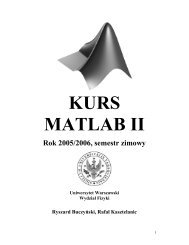
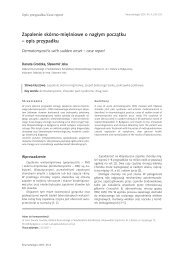
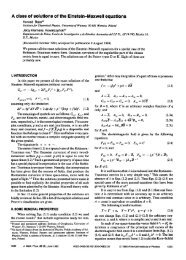
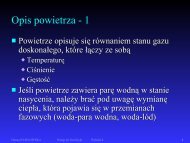
![slajdy [PDF, 0,6 MiB] - Instytut Geofizyki](https://img.yumpu.com/22546539/1/190x143/slajdy-pdf-06-mib-instytut-geofizyki.jpg?quality=85)
